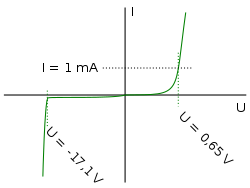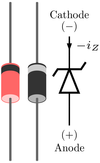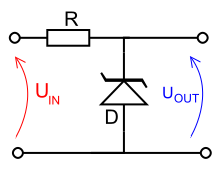| Revision as of 18:57, 14 September 2015 editJustBerry (talk | contribs)Extended confirmed users23,588 edits Reverted 1 good faith edit by Javed4122 using STiki← Previous edit | Revision as of 00:07, 15 September 2015 edit undo136.145.34.76 (talk)No edit summaryNext edit → | ||
| Line 11: | Line 11: | ||
| }} | }} | ||
| A '''Zener diode''' is a ] which allows current to flow in the forward direction in the same manner as an ideal diode, but also permits it to flow in the |
A '''Zener diode''' is a ] which allows current to flow in the forward direction in the same manner as an ideal diode, but also permits it to flow in the reverse. | ||
| The device was named after ], who discovered this electrical property. Strictly speaking, a Zener diode is one in which the reverse breakdown is due to electron ] under high electric field strength—the ]. However, many diodes described as "Zener" diodes rely instead on ] as the mechanism. Both types are used with the Zener effect predominating under {{nowrap|5.6 V}} and ] above. Common applications include providing a reference voltage for ]s, or to protect other semiconductor devices from momentary voltage pulses. | The device was named after ], who discovered this electrical property. Strictly speaking, a Zener diode is one in which the reverse breakdown is due to electron ] under high electric field strength—the ]. However, many diodes described as "Zener" diodes rely instead on ] as the mechanism. Both types are used with the Zener effect predominating under {{nowrap|5.6 V}} and ] above. Common applications include providing a reference voltage for ]s, or to protect other semiconductor devices from momentary voltage pulses. | ||
Revision as of 00:07, 15 September 2015
 Zener diode Zener diode | |
| Type | Passive |
|---|---|
| Working principle | Zener breakdown |
| Inventor | Clarence Melvin Zener |
| Pin names | anode and cathode |
| Electronic symbol | |
A Zener diode is a diode which allows current to flow in the forward direction in the same manner as an ideal diode, but also permits it to flow in the reverse. The device was named after Clarence Zener, who discovered this electrical property. Strictly speaking, a Zener diode is one in which the reverse breakdown is due to electron quantum tunnelling under high electric field strength—the Zener effect. However, many diodes described as "Zener" diodes rely instead on avalanche breakdown as the mechanism. Both types are used with the Zener effect predominating under 5.6 V and avalanche breakdown above. Common applications include providing a reference voltage for voltage regulators, or to protect other semiconductor devices from momentary voltage pulses.
Operation


A conventional solid-state diode allows significant current if it is reverse-biased above its reverse breakdown voltage. When the reverse bias breakdown voltage is exceeded, a conventional diode is subject to high current due to avalanche breakdown. Unless this current is limited by circuitry, the diode may be permanently damaged due to overheating. A Zener diode exhibits almost the same properties, except the device is specially designed so as to have a reduced breakdown voltage, the so-called Zener voltage. By contrast with the conventional device, a reverse-biased Zener diode exhibits a controlled breakdown and allows the current to keep the voltage across the Zener diode close to the Zener breakdown voltage. For example, a diode with a Zener breakdown voltage of 3.2 V exhibits a voltage drop of very nearly 3.2 V across a wide range of reverse currents. The Zener diode is therefore ideal for applications such as the generation of a reference voltage (e.g. for an amplifier stage), or as a voltage stabilizer for low-current applications.
Another mechanism that produces a similar effect is the avalanche effect as in the avalanche diode. The two types of diode are in fact constructed the same way and both effects are present in diodes of this type. In silicon diodes up to about 5.6 volts, the Zener effect is the predominant effect and shows a marked negative temperature coefficient. Above 5.6 volts, the avalanche effect becomes predominant and exhibits a positive temperature coefficient.
In a 5.6 V diode, the two effects occur together, and their temperature coefficients nearly cancel each other out, thus the 5.6 V diode is useful in temperature-critical applications. An alternative, which is used for voltage references that need to be highly stable over long periods of time, is to use a Zener diode with a temperature coefficient of +2 mV/°C (breakdown voltage 6.2–6.3 V) connected in series with a forward-biased silicon diode (or a transistor B-E junction) manufactured on the same chip. The forward-biased diode has a temperature coefficient of −2 mV/°C, causing the TCs to cancel out.
Modern manufacturing techniques have produced devices with voltages lower than 5.6 V with negligible temperature coefficients, but as higher-voltage devices are encountered, the temperature coefficient rises dramatically. A 75 V diode has 10 times the coefficient of a 12 V diode.
Zener and avalanche diodes, regardless of breakdown voltage, are usually marketed under the umbrella term of "Zener diode".
Waveform clipper

 Examples of a Waveform Clipper
Examples of a Waveform Clipper
Two Zener diodes facing each other in series will act to clip both halves of an input signal. Waveform clippers can be used to not only reshape a signal, but also to prevent voltage spikes from affecting circuits that are connected to the power supply.
Voltage shifter

 Examples of a Voltage Shifter
Examples of a Voltage Shifter
A Zener diode can be applied to a circuit with a resistor to act as a voltage shifter. This circuit lowers the input voltage by a quantity that is equal to the Zener diode's breakdown voltage.
Voltage regulator

 Examples of a Voltage Regulator
Examples of a Voltage Regulator
A Zener diode can be applied to a circuit to regulate the voltage applied to a load, such as in a linear regulator.
Construction
The Zener diode's operation depends on the heavy doping of its p-n junction. The depletion region formed in the diode is very thin (<1 µm) and the electric field is consequently very high (about 500 kV/m) even for a small reverse bias voltage of about 5 V, allowing electrons to tunnel from the valence band of the p-type material to the conduction band of the n-type material.
In the atomic scale, this tunneling corresponds to the transport of valence band electrons into the empty conduction band states; as a result of the reduced barrier between these bands and high electric fields that are induced due to the relatively high levels of dopings on both sides. The breakdown voltage can be controlled quite accurately in the doping process. While tolerances within 0.07% are available, the most widely used tolerances are 5% and 10%. Breakdown voltage for commonly available Zener diodes can vary widely from 1.2 volts to 200 volts.
Surface Zeners
The emitter-base junction of a bipolar NPN transistor behaves as a Zener diode, with breakdown voltage at about 6.8 V for common bipolar processes and about 10 V for lightly doped base regions in BiCMOS processes. Older processes with poor control of doping characteristics had the variation of Zener voltage up to ±1 V, newer processes using ion implantation can achieve no more than ±0.25 V. The NPN transistor structure can be employed as a surface Zener diode, with collector and emitter connected together as its cathode and base region as anode. In this approach the base doping profile usually narrows towards the surface, creating a region with intensified electric field where the avalanche breakdown occurs. The hot carriers produced by acceleration in the intense field sometime shoot into the oxide layer above the junction and become trapped there. The accumulation of trapped charges can then cause 'Zener walkout', a corresponding change of the Zener voltage of the junction. The same effect can be achieved by radiation damage.
The emitter-base Zener diodes can handle only smaller currents as the energy is dissipated in the base depletion region which is very small. Higher amount of dissipated energy (higher current for longer time, or a short very high current spike) causes thermal damage to the junction and/or its contacts. Partial damage of the junction can shift its Zener voltage. Total destruction of the Zener junction by overheating it and causing migration of metallization across the junction ("spiking") can be used intentionally as a 'Zener zap' antifuse.
Subsurface Zeners
A subsurface Zener diode, also called 'buried Zener', is a device similar to the Surface Zener, but with the avalanche region located deeper in the structure, typically several micrometers below the oxide. The hot carriers then lose energy by collisions with the semiconductor lattice before reaching the oxide layer and cannot be trapped there. The Zener walkout phenomenon therefore does not occur here, and the buried Zeners have voltage constant over their entire lifetime. Most buried Zeners have breakdown voltage of 5–7 volts. Several different junction structures are used.
Uses

Zener diodes are widely used as voltage references and as shunt regulators to regulate the voltage across small circuits. When connected in parallel with a variable voltage source so that it is reverse biased, a Zener diode conducts when the voltage reaches the diode's reverse breakdown voltage. From that point on, the relatively low impedance of the diode keeps the voltage across the diode at that value.

In this circuit, a typical voltage reference or regulator, an input voltage, UIN, is regulated down to a stable output voltage UOUT. The breakdown voltage of diode D is stable over a wide current range and holds UOUT relatively constant even though the input voltage may fluctuate over a fairly wide range. Because of the low impedance of the diode when operated like this, resistor R is used to limit current through the circuit.
In the case of this simple reference, the current flowing in the diode is determined using Ohm's law and the known voltage drop across the resistor R;
The value of R must satisfy two conditions :
- R must be small enough that the current through D keeps D in reverse breakdown. The value of this current is given in the data sheet for D. For example, the common BZX79C5V6 device, a 5.6 V 0.5 W Zener diode, has a recommended reverse current of 5 mA. If insufficient current exists through D, then UOUT is unregulated and less than the nominal breakdown voltage (this differs to voltage-regulator tubes where the output voltage will be higher than nominal and could rise as high as UIN). When calculating R, allowance must be made for any current through the external load, not shown in this diagram, connected across UOUT.
- R must be large enough that the current through D does not destroy the device. If the current through D is ID, its breakdown voltage VB and its maximum power dissipation PMAX correlate as such: .
A load may be placed across the diode in this reference circuit, and as long as the Zener stays in reverse breakdown, the diode provides a stable voltage source to the load. Zener diodes in this configuration are often used as stable references for more advanced voltage regulator circuits.
Shunt regulators are simple, but the requirements that the ballast resistor be small enough to avoid excessive voltage drop during worst-case operation (low input voltage concurrent with high load current) tends to leave a lot of current flowing in the diode much of the time, making for a fairly wasteful regulator with high quiescent power dissipation, only suitable for smaller loads.
These devices are also encountered, typically in series with a base-emitter junction, in transistor stages where selective choice of a device centered around the avalanche or Zener point can be used to introduce compensating temperature co-efficient balancing of the transistor p–n junction. An example of this kind of use would be a DC error amplifier used in a regulated power supply circuit feedback loop system.
Zener diodes are also used in surge protectors to limit transient voltage spikes.
Another application of the Zener diode is the use of noise caused by its avalanche breakdown in a random number generator.
See also
References
- ^ Millman, Jacob (1979). Microelectronics. McGraw Hill. pp. 45–48. ISBN 978-0071005968.
- ^ Dorf, Richard C., ed. (1993). The Electrical Engineering Handbook. Boca Raton: CRC Press. p. 457. ISBN 0-8493-0185-8.
- Calibration: Philosophy in Practice. Fluke. 1994. pp. 7–10. ISBN 0963865005.
- Diffenderfer, Robert (2005). Electronic Devices: Systems and Applications. Thomas Delmar Learning. pp. 95–100. ISBN 1401835147. Retrieved July 22, 2014.
- Comer, Donald T. (1996). "Zener Zap Anti-Fuse Trim in VLSI Circuits". VLSI Design. 5: 89. doi:10.1155/1996/23706.
{{cite journal}}: CS1 maint: unflagged free DOI (link) - Hastings, Alan (2005). The Art of Analog Layout (Second ed.). Prentice Hall. ISBN 9780131464100.
- Horowitz, Paul; Hill, Winfield (1989). The Art of Electronics (2nd ed.). Cambridge University Press. pp. 68–69. ISBN 0-521-37095-7.
- "BZX79C5V6 − 5.6V, 0.5W Zener Diode - data sheet". Fairchild Semiconductor. Retrieved July 22, 2014.
External links
- Video tutorial about Zener diodes and their practical applications
- Zener diode theory and thermal calculations
Further reading
- TVS/Zener Theory and Design Considerations; ON Semiconductor; 127 pages; 2005; HBD854/D. (Free PDF download)
 is shown.
is shown.
 .
.